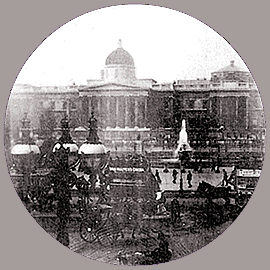Wordsworth Donisthorpe
Wordsworth Donisthorpe (Leeds, 24 March 1847 – Shottermill, 30 January 1914)[1] was an English barrister,[2] individualist anarchist[3] and inventor, pioneer of cinematography and chess enthusiast. His father was George E. Donisthorpe, also an inventor;[4] his brother, Horace Donisthorpe, was a myrmecologist.
.png)

Donisthorpe spoke on anarchism at a conference organised by the Fabian Society in 1886.[5] He was associated with the Liberty and Property Defence League and edited their Jus journal until his split from the League in 1888.[2][6]
In 1885, Donisthorpe was co-founder of the British Chess Association and the British Chess Club.[4]
Donisthorpe filed for a patent in 1876, for a film camera, which he named a "kinesigraph."[4] The object of the invention was to:
facilitate the taking of a succession of photographic pictures at equal intervals of time, in order to record the changes taking place in or the movement of the object being photographed, and also by means of a succession of pictures so taken of any moving object to give to the eye a presentation of the object in continuous movement as it appeared when being photographed.[4][7]
According to Donisthorpe, he produced a model of this camera around the late 1870s.[8] In 1890 he also produced, together with his cousin W. C. Crofts, a moving picture of London's Trafalgar Square.[9] The camera that produced this moving picture was patented in 1889 along with the projector necessary to show the motion frames.[10]
Bibliography
- Principles of Plutology. London: Williams & Norgate. 1876.
- The claims of labour, or, Serfdom, Wagedom, and Freedom. London: Samuel Tinsley & Co. 1880.
- Empire and Liberty, a Lecture on the Principles of Local Government. London: Liberty and Property Defence League. 1886.
- Labour capitalization. London: G. Harmsworth & Co. 1887.
- Individualism, a System of Politics. London: Macmillan. 1889.
- Love and Law: An Essay on Marriage. London: W. Reeves. 1893.
- Law in a Free State. London: Macmillan. 1895.
- Down the stream of civilization. London: George Newnes. 1898.
References
- Gaige, Jeremy (1987). Chess Personalia, A Biobibliography. McFarland. p. 96. ISBN 0-7864-2353-6.
- Mingardi, Alberto (2011). Herbert Spencer. Continuum. p. 123. ISBN 9780826424860.
- Edward Bristow quotes Donisthorpe in the Westminster Gazette: "The Late Lord Bramwell, Tolstoi, Herbert Spencer, Benjamin Tucker, Vaillart, Auberon Herbert, J.H Levy, Kropotkin, the late Charles Bradlaugh, Yves Guyot, Caserio, and thousands of smaller fry, including myself, are anarchists". Bristow, Edward (1970). "The defence of liberty and property in Britain, 1880-1914". Yale University. Cite journal requires
|journal=(help) - Herbert, Stephen; Coe, Brian (2000). "Who's Who of Victorian Cinema". Retrieved 10 May 2009.
- Pease, Edward R. (1916). The History of the Fabian Society. p. 47. ISBN 9781465502483.
- Ryley, Peter (2013). Making Another World Possible: Anarchism, Anti-capitalism and Ecology in Late 19th and Early 20th Century Britain. Bloomsbury. pp. 60–69. ISBN 9781441153777.
- Burns, R. W. (1998). Television: An International History of the Formative Years. London: Institution of Engineering and Technology. ISBN 0-85296-914-7.
- "Cinema Studies". 1960.
- Burns, Paul T. "The History of The Discovery of Cinematography - 1885 - 1889". Retrieved 10 May 2009. and "Ten Remaining Frames Of Donisthorpe's 1890 'Trafalgar Square' Footage Come To Life" (GIF). Retrieved 10 May 2009.
- Herbert, S. (1998). Industry, Liberty, and a Vision: Wordsworth Donisthorpe's Kinesigraph. London: The Projection Box. ISBN 0-9523941-3-8.
- Bristow, Edward (1975). "The Liberty and Property Defence League and Individualism". Historical Journal. 18 (4): 761–789. doi:10.1017/S0018246X00008888.
- Barker, Rodney (1997). Political Ideas in Modern Britain. Routledge. ISBN 0-415-07121-6.
Works online
- The claims of labour, or, Serfdom, Wagedom, and Freedom (1880).
- Labour capitalization (1887).
- Individualism: A System of Politics (1889).
- "The Woes of an Anarchist", Liberty (25 January 1890). Reprinted in Benjamin Tucker, Instead of a Book (1897).
- "L'État Est Mort; Vive L'État!", Liberty (23 May 1890). Reprinted in Benjamin Tucker, Instead of a Book (1897).
- Law in a Free State (1895).
External links
- Wordsworth Donisthorpe player profile and games at Chessgames.com